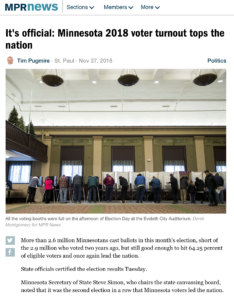 It’s official. During the recent 2018 elections, about 64% of Minnesotans voted, including 73% in the third congressional district. That’s the best rate of voter participation in the nation, a familiar spot for Minnesota. Local massage therapists are reporting record-breaking business as smug Minnesotans seek relief following vigorous self back-patting.
It’s official. During the recent 2018 elections, about 64% of Minnesotans voted, including 73% in the third congressional district. That’s the best rate of voter participation in the nation, a familiar spot for Minnesota. Local massage therapists are reporting record-breaking business as smug Minnesotans seek relief following vigorous self back-patting.
Good for us, again. But here are a couple important things we need to do in the next legislative session to up our game, so we can hold onto that top spot.
Automatic Voter Registration
First, we need to remove bureaucratic hassles from the voter registration process.
Like most states, Minnesota still has “opt in” voter registration. Under this approach, an eligible voter must proactively find and fill out a voter registration application. It’s a bit of a pain, particularly if you’re a young adult who hasn’t yet built up a tolerance for paperwork or knowledge of the workings of government.
Under the automatic voter registration model that should be adopted in Minnesota, citizens are proactively registered to vote unless they “opt out.” As of October of this year, 14 states are using various forms of automatic voter registration.
Just as an example, Oregon seems to have a good system. In that state, the DMV automatically shares voter registration-relevant data with the election agency. When computers determine that age, citizenship and residency requirements have all been met, the election agency mails out a registration notification card.
On the card, the resident has three choices: a) Choose a party affiliation and mail the card back; b) Check a box on the card to opt out of registration; or c) Do nothing, and after three weeks become automatically registered to vote as “unaffiliated.” That’s it. It makes democracy as easy as it should be.
To be sure, being registered to vote obviously doesn’t guarantee participation. Far from it. But it at least removes that initial barrier. Whether automatic voter registration leads to more participation or simply makes a needlessly cumbersome process more user-friendly and efficient, Minnesota needs to do this.
Vote By Mail
Second, Minnesota needs to make the process of voting much more convenient.
In a modern society, we can do just about everything without leaving home, such as hold meetings, shop, and fill out government paperwork . But we still require citizens to leave their homes to vote in person, unless they proactively go to the trouble of securing an absentee ballot. That makes voting more difficult than it needs to be, especially if you’re old, sick, hurt, disabled, in a remote location, or lacking transportation.
We can do better. In case you’ve missed this news, we have something called a mail system. That means we can mail all registered voters a ballot, and let them study issues and candidates at home and mail it back at their convenience, within a set election period.
Variously called “vote by mail,” “vote at home,” or “all mail elections,” this is lot like the tried-and-true absentee voting system, with one obvious advantage: You don’t have to request a ballot.
The ballot just arrives in all registered voters’ mail at the beginning of an election period, without having to request it. In terms of convenience, it’s sort of like the difference between having to physically go to a utility office to hand over a payment in person versus having a utility bill mailed to you so you can pay by mail without leaving your home.
If that much convenience is objectionable to you, or you’re one of those many traditionalists, fine, we’ll still have a smaller number of physical locations for some of you holdouts. Enjoy your time in line.
Vote-by-mail is obviously more convenient than voting in person, and it breaks down barriers to voting. The nonpartisan National Council on State Legislatures (NCSL) notes that research finds “turnout increases by single digits for presidential elections and more in smaller elections.” That alone is enough reason to make the change.
But wait, there’s more! Vote-by-mail also is about 40 percent cheaper for taxpayers than traditional elections, according to a 2016 Pew study of Colorado’s experience.
Fraud, you ask? All election systems, including the current system, carry the possibility of fraud, as would vote-by-mail. But as the National Vote at Home Coalition (NVAHC) notes:
“Oregon has mailed-out more than 100 million ballots since 2000, with about a dozen cases of proven fraud.” That’s a 0.00000012 percent rate of fraud.”
Importantly, vote by mail also has a huge anti-fraud advantage. Voting by mail leaves a trackable, auditable paper trail, which cybersecurity experts tell us is the surest way to thwart hacking and ensure election integrity. In that very important way, vote by mail is much less prone to fraud than the current election system, particularly where voting machines are in use.
As an aside, I wish we could do online voting to save some trees. But cybersecurity experts say online voting would be too prone to hacking. So vote by mail is the next best thing.
Minnesota legislators don’t like to be trailblazers, but we don’t have to go out on a limb on this one. Oregon has been successfully using vote by mail this for 18 years, and 22 other states have followed their lead.
So while we Minnesotans are justifiably celebrating our civically engaged selves, we shouldn’t rest on our laurels. If we want to maintain our top spot and strengthen our democracy, we’re going to need to take these steps to break down more of our remaining barriers to voting.

